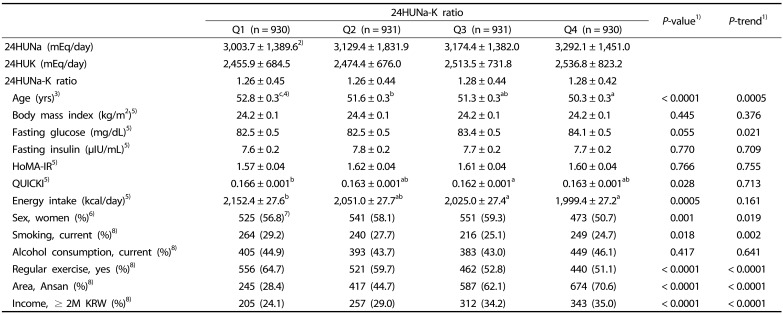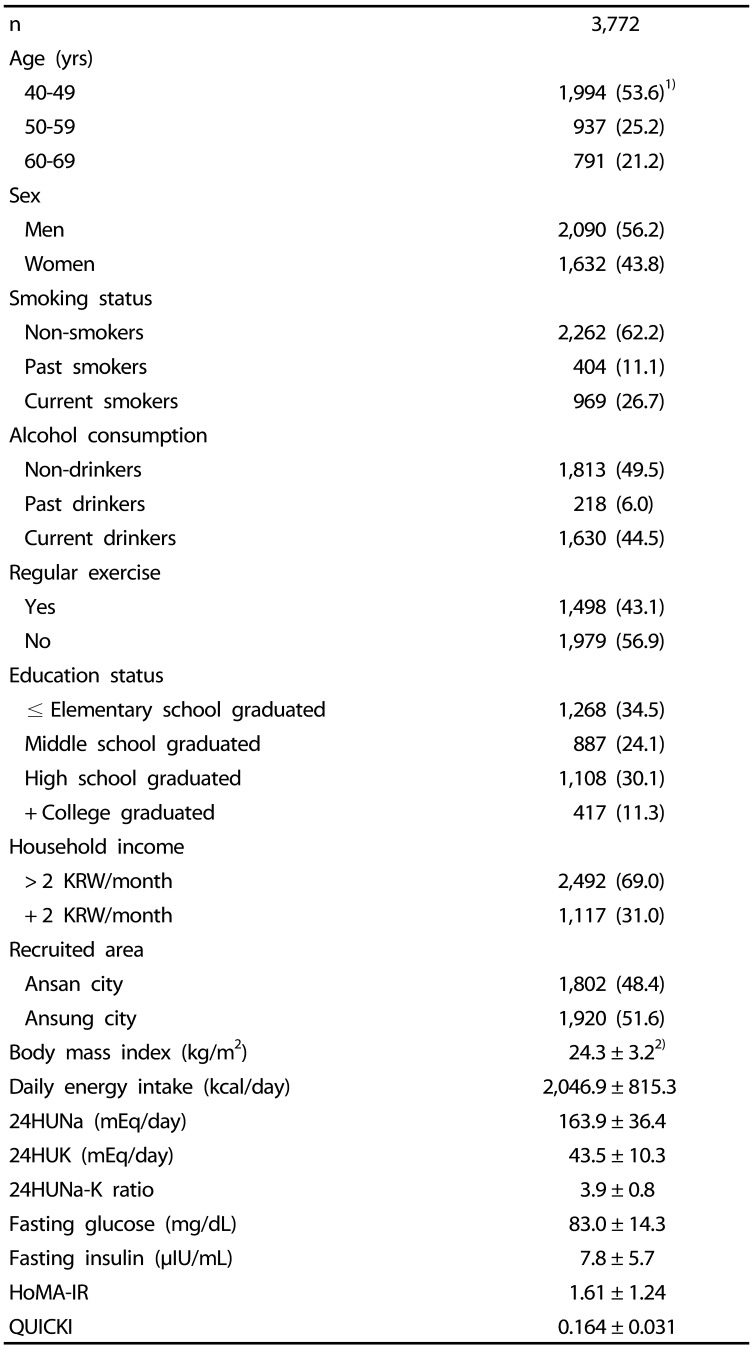1. Statistics Korea. Annual Report on the Causes of Death Statistics. Daejeon: Statistics Korea;2016.
2. Ginsberg HN. Insulin resistance and cardiovascular disease. J Clin Invest. 2000; 106:453–458. PMID:
10953019.

3. Reaven GM. Insulin resistance, the insulin resistance syndrome, and cardiovascular disease. Panminerva Med. 2005; 47:201–210. PMID:
16489319.
4. Paneni F, Costantino S, Cosentino F. Insulin resistance, diabetes, and cardiovascular risk. Curr Atheroscler Rep. 2014; 16:419. PMID:
24781596.

5. Patel TP, Rawal K, Bagchi AK, Akolkar G, Bernardes N, Dias DS, Gupta S, Singal PK. Insulin resistance: an additional risk factor in the pathogenesis of cardiovascular disease in type 2 diabetes. Heart Fail Rev. 2016; 21:11–23. PMID:
26542377.

6. Ames RP. The effect of sodium supplementation on glucose tolerance and insulin concentrations in patients with hypertension and diabetes mellitus. Am J Hypertens. 2001; 14:653–659. PMID:
11465650.

7. Kuroda S, Uzu T, Fujii T, Nishimura M, Nakamura S, Inenaga T, Kimura G. Role of insulin resistance in the genesis of sodium sensitivity in essential hypertension. J Hum Hypertens. 1999; 13:257–262. PMID:
10333344.

8. Dziwura J, Bińczak-Kuleta A, Miazgowski T, Ziemak J, Widecka K. The associations between G972R polymorphism of the IRS-1 gene, insulin resistance, salt sensitivity and non-dipper hypertension. Hypertens Res. 2011; 34:1082–1086. PMID:
21677657.

9. Wan Z, Wen W, Ren K, Zhou D, Liu J, Wu Y, Zhou J, Mu J, Yuan Z. Involvement of NLRP3 inflammasome in the impacts of sodium and potassium on insulin resistance in normotensive Asians. Br J Nutr. 2018; 119:228–237. PMID:
29359681.

10. Chatterjee R, Slentz C, Davenport CA, Johnson J, Lin PH, Muehlbauer M, D'Alessio D, Svetkey LP, Edelman D. Effects of potassium supplements on glucose metabolism in African Americans with prediabetes: a pilot trial. Am J Clin Nutr. 2017; 106:1431–1438. PMID:
29092881.

11. Townsend RR, Kapoor S, McFadden CB. Salt intake and insulin sensitivity in healthy human volunteers. Clin Sci (Lond). 2007; 113:141–148. PMID:
17425514.

12. Raji A, Williams GH, Jeunemaitre X, Hopkins PN, Hunt SC, Hollenberg NK, Seely EW. Insulin resistance in hypertensives: effect of salt sensitivity, renin status and sodium intake. J Hypertens. 2001; 19:99–105. PMID:
11204310.
13. Nakandakare ER, Charf AM, Santos FC, Nunes VS, Ortega K, Lottenberg AM, Mion D Jr, Nakano T, Nakajima K, D'Amico EA, Catanozi S, Passarelli M, Quintão EC. Dietary salt restriction increases plasma lipoprotein and inflammatory marker concentrations in hypertensive patients. Atherosclerosis. 2008; 200:410–416. PMID:
18262533.

14. Garg R, Williams GH, Hurwitz S, Brown NJ, Hopkins PN, Adler GK. Low-salt diet increases insulin resistance in healthy subjects. Metabolism. 2011; 60:965–968. PMID:
21036373.

15. Meland E, Laerum E, Aakvaag A, Ulvik RJ, Høstmark AT. Salt restriction: effects on lipids and insulin production in hypertensive patients. Scand J Clin Lab Invest. 1997; 57:501–505. PMID:
9350069.

16. Foo M, Denver AE, Coppack SW, Yudkin JS. Effect of salt-loading on blood pressure, insulin sensitivity and limb blood flow in normal subjects. Clin Sci (Lond). 1998; 95:157–164. PMID:
9680497.

17. Ministry of Health and Welfare (KR). Korea Health Statistics 2014: Korea National Health and Nutrition Examination Survey (KNHANES VI-2). Cheongju: Korea Centers for Disease Control and Prevention;2015.
18. Iwahori T, Miura K, Ueshima H. Time to consider use of the sodium-to-potassium ratio for practical sodium reduction and potassium increase. Nutrients. 2017; 9:700.

19. McLean RM. Measuring population sodium intake: a review of methods. Nutrients. 2014; 6:4651–4662. PMID:
25353661.

20. Kim Y, Han BG. KoGES group. Cohort profile: the Korean Genome and Epidemiology Study (KoGES) consortium. Int J Epidemiol. 2017; 46:1350. PMID:
28938752.

21. Kim J, Kim Y, Ahn YO, Paik HY, Ahn Y, Tokudome Y, Hamajima N, Inoue M, Tajima K. Development of a food frequency questionnaire in Koreans. Asia Pac J Clin Nutr. 2003; 12:243–250. PMID:
14505984.
22. Ahn Y, Kwon E, Shim JE, Park MK, Joo Y, Kimm K, Park C, Kim DH. Validation and reproducibility of food frequency questionnaire for Korean genome epidemiologic study. Eur J Clin Nutr. 2007; 61:1435–1441. PMID:
17299477.

23. Park YM, Kwock CK, Kim K, Kim J, Yang YJ. Interaction between single nucleotide polymorphism and urinary sodium, potassium, and sodium-potassium ratio on the risk of hypertension in Korean adults. Nutrients. 2017; 9:235.

24. Tanaka T, Okamura T, Miura K, Kadowaki T, Ueshima H, Nakagawa H, Hashimoto T. A simple method to estimate populational 24-h urinary sodium and potassium excretion using a casual urine specimen. J Hum Hypertens. 2002; 16:97–103. PMID:
11850766.

25. O'Donnell M, Mente A, Rangarajan S, McQueen MJ, Wang X, Liu L, Yan H, Lee SF, Mony P, Devanath A, Rosengren A, Lopez-Jaramillo P, Diaz R, Avezum A, Lanas F, Yusoff K, Iqbal R, Ilow R, Mohammadifard N, Gulec S, Yusufali AH, Kruger L, Yusuf R, Chifamba J, Kabali C, Dagenais G, Lear SA, Teo K, Yusuf S. PURE Investigators. Urinary sodium and potassium excretion, mortality, and cardiovascular events. N Engl J Med. 2014; 371:612–623. PMID:
25119607.
26. O'Donnell MJ, Yusuf S, Mente A, Gao P, Mann JF, Teo K, McQueen M, Sleight P, Sharma AM, Dans A, Probstfield J, Schmieder RE. Urinary sodium and potassium excretion and risk of cardiovascular events. JAMA. 2011; 306:2229–2238. PMID:
22110105.
27. Khaw KT, Bingham S, Welch A, Luben R, O'Brien E, Wareham N, Day N. Blood pressure and urinary sodium in men and women: the Norfolk Cohort of the European Prospective Investigation into Cancer (EPIC-Norfolk). Am J Clin Nutr. 2004; 80:1397–1403. PMID:
15531692.

28. Matthews DR, Hosker JP, Rudenski AS, Naylor BA, Treacher DF, Turner RC. Homeostasis model assessment: insulin resistance and beta-cell function from fasting plasma glucose and insulin concentrations in man. Diabetologia. 1985; 28:412–419. PMID:
3899825.
29. Katz A, Nambi SS, Mather K, Baron AD, Follmann DA, Sullivan G, Quon MJ. Quantitative insulin sensitivity check index: a simple, accurate method for assessing insulin sensitivity in humans. J Clin Endocrinol Metab. 2000; 85:2402–2410. PMID:
10902785.

30. Chun YH, Han K, Kim DH, Park YG, Cho KH, Choi YS, Kim SM, Kim YH, Nam GE. Association of urinary sodium excretion with insulin resistance in Korean adolescents: results from the Korea National Health and Nutrition Examination Survey 2009-2010. Medicine (Baltimore). 2016; 95:e3447. PMID:
27124037.
31. Kim YM, Kim SH, Shim YS. Association of sodium intake with insulin resistance in Korean children and adolescents: the Korea National Health and Nutrition Examination Survey 2010. J Pediatr Endocrinol Metab. 2018; 31:117–125. PMID:
29303781.

32. Fonseca-Alaniz MH, Brito LC, Borges-Silva CN, Takada J, Andreotti S, Lima FB. High dietary sodium intake increases white adipose tissue mass and plasma leptin in rats. Obesity (Silver Spring). 2007; 15:2200–2208. PMID:
17890487.

33. Lopes KL, Furukawa LN, de Oliveira IB, Dolnikoff MS, Heimann JC. Perinatal salt restriction: a new pathway to programming adiposity indices in adult female Wistar rats. Life Sci. 2008; 82:728–732. PMID:
18289603.

34. Fonseca-Alaniz MH, Takada J, Andreotti S, de Campos TB, Campaña AB, Borges-Silva CN, Lima FB. High sodium intake enhances insulin-stimulated glucose uptake in rat epididymal adipose tissue. Obesity (Silver Spring). 2008; 16:1186–1192. PMID:
18369340.

35. Hall JE. Control of sodium excretion by angiotensin II: intrarenal mechanisms and blood pressure regulation. Am J Physiol. 1986; 250:R960–R972. PMID:
3521337.

36. Wasada T. Adenosine triphosphate-sensitive potassium (K
ATP) channel activity is coupled with insulin resistance in obesity and type 2 diabetes mellitus. Intern Med. 2002; 41:84–90. PMID:
11868613.






 PDF
PDF ePub
ePub Citation
Citation Print
Print




 XML Download
XML Download